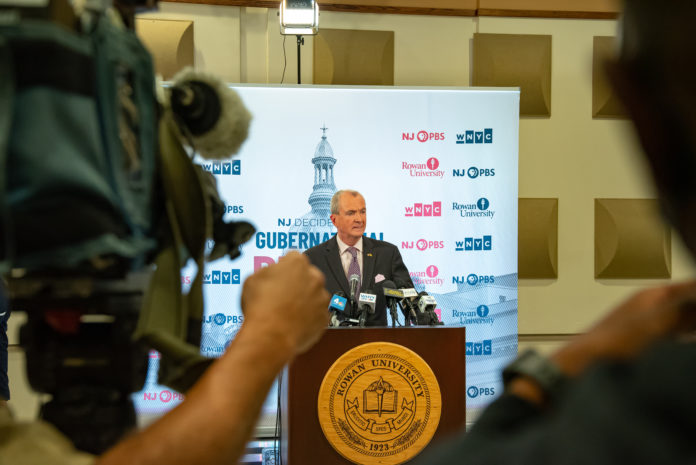
It’s been just over a week since most major news agencies projected Democratic incumbent Phil Murphy as the winner in the race for governor, but still, Republican candidate Jack Ciatteralli has not yet conceded. Trailing by nearly three percentage points, he says that he simply wants all votes to be counted before he makes his decision. And, until Wednesday, he wasn’t alone.
Enter State Senate President Steve Sweeney (D-West Deptford), a fixture of New Jersey politics for more than a decade and one of the most powerful figures in the state. Four years ago, Sweeney won the largest electoral victory in his career, beating Republican Fran Grenier by eighteen points despite the New Jersey Education Association (longtime foes of Sweeney) spending millions of dollars trying to unseat him.
On election night, the number two Democrat in the state found himself trailing Republican Ed Durr, a truck driver whose campaign spent only about two thousand dollars.
Sweeney refused to concede, perhaps in a legitimate effort to wait for more votes to come in, or perhaps in disbelief that he had been the victim of one of the largest political upsets not just in New Jersey history, but maybe in American legislative history. Realizing his untenable position, a crushed Steve Sweeney stepped up to the podium in Trenton on Wednesday, Nov. 11, and conceded the election to Mr. Durr, his voice breaking as he reminisced on his time in the State Senate.
Alongside this titan of New Jersey politics falling, Democrats across the state faced extremely tough challenges from Republicans, with Governor Murphy being reelected by a much closer than the expected margin, and statehouse Democrats losing two State Senate seats and six seats in the Assembly. All of this electoral chaos and political shock begs the question: what exactly happened on election day?
While victorious in being the state’s first Democratic governor to be reelected since Brendan Bryne in 1977, Phil Murphy just squeezed out a victory that was close due to poor turnout and a massive enthusiasm gap between Democrats and Republicans. Once again, the polls failed to get even remotely close to the real margins, as the final poll from the Monmouth University Polling Institute showed Murphy leading by nearly 11 points.
“No one was expecting a Murphy loss, the question was how much would he win by,” said Brent Johnson, statehouse reporter for The Star-Ledger. “Basically what seems to have happened is this was a low turnout election and Republicans turned out in larger numbers than anyone thought they would. So it was kind of a crazy, unexpected election.”
Dr. Ben Dworkin, founding director of the Rowan Institute for Public Policy and Citizenship, concurred and felt that even among those who had been paying extremely close attention to the election, there had been two things that were visible among the electorate but were under-appreciated.
“First, the headwind caused by Democratic dysfunction in Washington D.C., which contributed to lower enthusiasm among the Democratic base,” Dworkin said. “And the second headwind was the anger, the frustration, and the bitterness of the electorate. People who were angry and frustrated with just life and the difficulties that everyone is facing finally had a chance to let their voice be heard and they took advantage of it.”
The enthusiasm gap was evident everywhere you went in the month leading up to election day. Despite New Jersey being a Democratic stronghold, it looked as though Jack Ciattarelli’s signs greatly outnumbered Phil Murphy’s signs. While lawn signs are by no means a perfect indicator of exactly where enthusiasm lies, they can give a clue as to how voters of a particular party are feeling about their candidate leading up to election day. This in turn can indicate how turnout may be. To Dworkin, it appeared as though the race was close not because of an independent swing towards Republicans, but rather it was due to a massive spike in turnout by Republican voters.
“For example, in Sweeney’s district, Republican voters who might have only been used to voting in a presidential race suddenly showed up for a legislative and gubernatorial race. Steve Sweeney got practically the same number of votes as he did four years ago when he won handily,” Dworkin asserted. “but what Mr. Durr was able to do was find ten to eleven thousand people who were Trump voters and typically only voted when Trump was on the ballot and have them vote in an off-year election. They caught many political observers and these campaigns by surprise because nobody expected these people to come out and vote.”
For Johnson, the legislative races, where Democrats lost two Senate seats and six Assembly seats, were where the real surprises were in this election.
“Everyone was expecting the Democrats to lose maybe a seat, maybe Jean Stanfield would beat Dawn Addiego [in the eighth district], but certainly not Vin Gopal, who’s in a very close race, and Steve Sweeney.”
With these losses in mind, one could assume Governor Murphy’s agenda for a second term, which was previously viewed to be more progressive than his first term, would be more subdued now that the Republicans have a stronger position in the statehouse.
“Republicans have said that this shows that voters rejected Murphy’s progressive agenda, and Murphy did tout his progressive achievements in his [victory] speech, but also noted that “I will listen to all New Jerseyans” which might have been a tip of the hat to the fact that the race was close,” Johnson said. “So yes, I don’t think it will be as a progressive second term as his first term, but it’s all unknown territory now.”
Sweeney’s loss is a massive blow to the South Jersey Democratic machine and could lead to immense changes in terms of legislative leadership and South Jersey’s political standing as a whole. The New Jersey Globe reported last week that an agreement was in place that would make Nicholas Scutari (D-Linden) the next New Jersey Senate President, however, Nia Gill (D-Montclair) has also entered into the race, having the support of Black clergyman and close Phil Murphy ally, Rev. Charles Boyer, which could further complicate matters for Senate Democrats.
“It’s a very delicate balance of power between South Jersey and North Jersey, and for more than a decade Steve Sweeney was an anchor on one side of that balance of power,” Dworkin said. “Now that he is gone, this is a power vacuum and new coalitions are forming by the minute. This region [South Jersey] benefited greatly from having a Senate President from this region. How that plays out in the future now that that representation is not there is left to be seen but without the Senate presidency it’s unclear how well this region will do when it competes for state resources.”
For comments/questions about this story tweet @TheWhitOnline or email thewhitnews23@gmail.com




